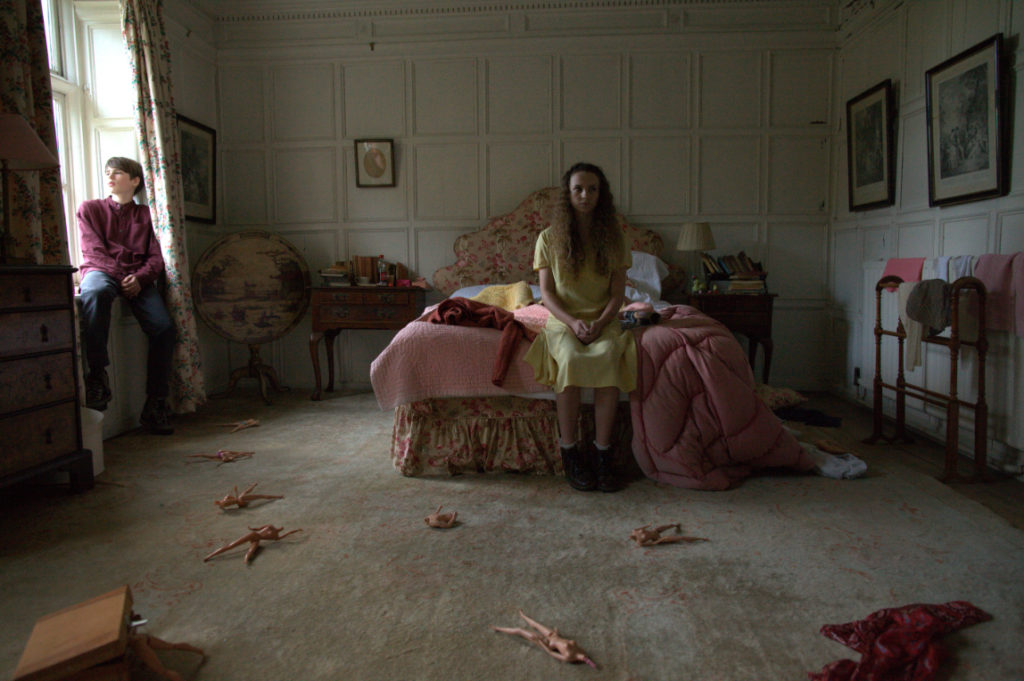
Meeting your partner’s family for the first time can be a drag, having to find out how well you get along in the family dynamic or learn some truths you may not want to be privy to. It is a scenario that has been used in cinema in almost any genre, comedy, horror, drama etc. Yet, such encounters still can maintain audience curiosity–like a car wreck you can’t look away. Horror fans, in particular, rejoice when these awkward scenarios break down into abject horror, and Sebastian Godwin’s Homebound places the audience in the squeamish position of unearthing some dark family truths.
Following a young couple, Richard and Holly, the two head to visits Richard’s two estranged children Anna and Ralph. With the kid’s birth mother absent, the family tries to rekindle long-lost bonds but something is off in the household. Soon, Holly finds herself overwhelmed by the sensation of a dark truth through the kid’s malicious actions towards her and Richard manifesting his own emotional problems attached to his past life.

From the opening introduction, with its ominous and intrusive musical score, Homebound makes itself clear that it is going to be an uneasy experience. In fact, much of the production is defined by keeping the viewer on edge and guessing as to what is the underlying issues in the family dynamic that have made it so perilous for an outsider to navigate. Add in the learning of family traditions from a cautious outsider in Holly, such as chasing and slaughtering a goose for a feast, and the environment around the young woman becomes uncomfortably fragile.
Holly is certainly the focal point of any elements of dread or horror, and her navigating the children’s disdain and violence towards her puts the film in a constantly uneasy balance that makes the production intense despite the lack of disturbing imagery. In this regard, Sebastian Godwin taps into social fearw that we all face, having the expectations of normalcy, even joy, replaced with confusion and fear. If viewers will take anything away from the production, it will be Godwin’s ability to navigate complex emotions and weave them into an object of abject horror.
Of course, this film would not be successful if not for convincing performances, of which Aisling Loftus as Holly does a remarkable job of showing her fears and discomfort–her expressions conveying deep emotional trauma and loneliness due to the situation. Across from Loftus, Tom Goodman-Hill a Richard presents a menacing figure of male power struggling for the respect he feels is deserved (it is not). In fact, it is really easy to despise Richard and everything he does, but that is the point.
The film ends on a high-point with a twist ending that is, somewhat, predictable yet wonderfully delectable. It is the kind of twist that should be avoided via spoilers, but the conclusion of the story is definitely rewarding.

Looking at the presentation, visually the film stays rather serviceable. The cinematography feels largely focused on capturing drama between the family members over creating an overarching sense of dread. There are some shots that allude to something sinister early in the production, but these scenes don’t feel definitive to the vibe. This is not necessarily a deterrent as the direction and script imbue that sense of horror needed to sell the narrative, but the end product won’t impress anyone with abstract or artistic visual storytelling.
The score, on the other hand, is perfectly executed and pushes that pervasive sense of dread that oozes out of every corner of the family interactions. It is not something to be admired on its own, with its intrusive use of classical instruments, but it is perfectly apt in bringing terror to life in Homebound.
While Sebastian Godwin’s debut film is not particularly unique in both content and delivery, it is an intelligently constructed horror film that can really put the viewer at unease. Those who enjoy finding horror in simple human interaction will undeniably get a kick out of how he twists this family gathering into an object of horror. Personally, I can’t wait to see what Godwin comes up with next as with a bit more visual flair he could become a notable name in horror.

We Watched Homebound courtesy of Bluefinch Releasing as part of Frigthfest Glasgow 2021

More Film Reviews
The Empty Man (2020) Team Review – Fear The Abyss
“The Empty Man is a supernatural horror film based on a popular series of Boom! Studios graphic novels. After a group of teens from a small Midwestern town begin to…
The Group (2022) Film Review – A Not-So-Safe Space
The Group, a 2022 film written and directed by William Higo, is a compelling and thought-provoking horror/drama that delves deep into the complexities of addiction, loyalty, and the consequences of…
Sweetie, You Won’t Believe It Movie Review – Fantasia Festival 2021
Fishing doesn’t have the best reputation in fiction. Going off literature and film and Dick Cheney, one gets the impression it’s boring, it’s vaguely cruel, and it mostly serves as…
Kami no Virusu (2022) Short Film Review
Kami No Virusu, directed by Luciano Attino, is a dystopian short film set in a future where a pandemic has ravaged the world. The story follows a shady pharmaceutical company…
The Human Trap (2021) Film Review – An indie Horror Diamond in the Rough
The Human Trap, a 2021 film by director Lee Moon-young, is a bizarre South Korean indie horror movie that teaches us to trust no one and always look out for…
The Sadness (2021) Film Review- A Powerful, Repellent Horror Spectacle
It was about halfway through watching Rob Jabbaz’s debut feature The Sadness that I realized I was in the hands of a maniac. Taipei resident Kat (Regina Lei) is hiding…





